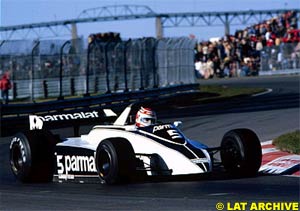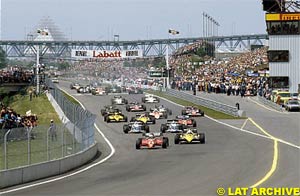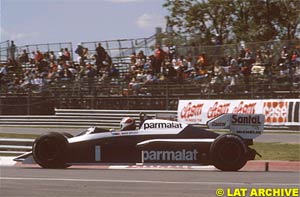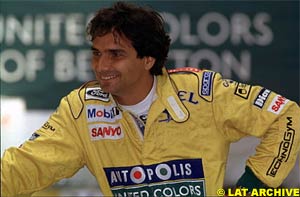
Atlas F1 Magazine Writer
In the history of the Canadian Grand Prix, Nelson Piquet has been one to constantly drive in the top positions, even though he sometimes didn't have the top material. He got his first big break in Canada back in 1978, when Bernie Ecclestone let him drive a Brabham, and he got his final win in Canada, courtesy of Nigel Mansell. Marcel Schot reviews the Brazilian's highs and lows at the Canadian venue.
With Ensign driver Derek Daly on his tail, Piquet continued the race to the best of his abilities. He moved into seventh when Patrick Depailler dropped back, but soon Daly moved ahead of him and Piquet was in eighth once again. After twenty laps Piquet suffered a severe setback. The Brazilian dropped back to eleventh, where he encountered Depailler again. Just as the Tyrrell driver passed him, ATS pilot Keke Rosberg was forced to visit the pits in order to have a seriously misfiring engine looked at. Once the race was past the halfway point, it became a struggle to survive for Piquet. Slowly he dropped back further and further. In the end, he finished the race in eleventh place, with only Renault driver Jean Pierre Jabouille several laps behind him.
This was by no means a dream start, but it was enough to get John Watson's seat for 1979. It became a season to forget. The Alfa V12 was as unreliable as it gets, allowing Piquet just four finishes in 13 races. As the team grew tired of the continuous trouble with the Italian engine, preparations were made to switch to Cosworth for the remainder of the season.
In Canada, they were finally ready, but on Friday morning Brabham suffered a serious setback when Niki Lauda told Ecclestone he quit. The Austrian walked out the door and left the team with only Piquet as their driver. Quickly Argentine Ricardo Zunino, who was in the paddock as a visitor, was put into the car and thus Piquet started his first race as a number one driver. The Cosworth proved worthwhile in qualifying, as Piquet managed a good fourth place and in the race it went great as well. After a decent start, Piquet moved into third and remained there for a long time, until his gearbox failed. Disappointed, he was left stranded just eleven laps before his first ever podium finish.
The deal with Cosworth worked out well the following year and Piquet took full profit with victories at Long Beach, Zandvoort and Monza. Coming to Canada, Piquet was leading the Championship, one point ahead of Williams driver Alan Jones. The two rivals qualified on the front row, with Piquet grabbing a magnificent pole, eight tenths faster than Jones. At the start, they both got off the grid well and thundered into the first corner side by side. Both drivers were totally unwilling to let the other one ahead, eventually clashing at the corner. As the two standing cars blocked the track, the race was red-flagged. Sadly for Piquet, his car was damaged beyond repair.
The Brazilian had to start in the spare car, which had a brand new engine in it. The only problem was that the engine hadn't been tested for a full race distance. At the restart, Piquet allowed Jones into the lead and Ligier's Didier Pironi into second. Just a few laps later, Nelson was comfortable with handling the new car as gentle as possible and he moved back into the lead. After 23 laps, however, the engine blew. While Jones went on to win the race, Piquet knew his Championship chances were now near zero.
From Friday on, Piquet showed he was the man to beat. First in the free practice session, where he beat the Williamses by over half a second and then in the first qualifying session where he was able to keep the gap. In Saturday qualifying, Reutemann was fastest, but not as fast as Piquet the previous day. The Brabham driver then caused a small incident by borrowing a tyre from his teammate Hector Rebaque, thus going over the maximum allowed number of tyres. His laps done with Rebaque's tyre were subsequently disallowed, but no other penalty was imposed.
Come raceday, there was rain. Now it was the turn for Reutemann to cause confusion, as he drove to the grid first in his regular car and then again in his spare car, both fitted with different rain tyres. Reutemann made up his mind on the grid and finally the race began. Jones surprised both Championship candidates and went into the lead, followed by Piquet, Alain Prost, Elio de Angelis and only then Reutemann.
For the Argentine it became apparent that his tyre choice had been the wrong one, as he dropped further and further back. The intense rain turned everything upside down and after ten laps Prost led, ahead of Jacques Laffite, Gilles Villeneuve and Watson, with Piquet in fifth and Reutemann in an unbelievable 15th. For Prost things started to go wrong then and the Frenchman dropped back to fourth by half distance.
Meanwhile, Piquet had a hard charging Didier Pironi on his tail until the unfortunate Frenchman's engine failed. With Reutemann a long way behind, Piquet understood that in this place, trying to improve position wasn't the smartest thing to do and he settled for fourth and eventually fifth as Bruno Giacomelli's Alfa got past him. Piquet this time went into the final race with the better chance and eventually went on to win his first World Championship.
The following year was Piquet's fourth full season at Brabham and a transition from normally aspirated Cosworth engines to BMW turbos. The Canadian Grand Prix had a transition of its own. The event was moved from its usual second to last spot in the season to about halfway through the calendar, following the second of the US races at Detroit and ahead of the Dutch Grand Prix. In Detroit, Piquet had suffered the humiliation of his career by not qualifying for the race. The Brazilian wasn't going to let that happen again and in Montreal he was fourth on the grid. On Sunday the cars lined up for the start. However, when the light turned green, Pironi's Ferrari stalled on the grid.
Of course, a restart was necessary and this time everyone got underway okay. Piquet quickly made his way up and after ten laps he grabbed the lead and never looked back. Rene Arnoux was the only one able to follow, but the Frenchman retired shortly after the halfway point, leaving Piquet with a lead of over 30 seconds. Nelson Piquet took victory, but with the tragedy of the day in mind, it was his least celebrated race win.
In 1983 nothing changed in Piquet's environment. It was still a BMW-powered Brabham and Riccardo Patrese was still his teammate. Piquet was strong throughout the season, but in Canada he ran into some bad luck. Even though Piquet qualified in third, his role in the race was rather limited. He started well, dropped back to fourth for a while, then back into third and finally retired after just 16 laps with a throttle failure.
The Brazilian then went on to grab his second Championship and thus he started the 1984 Canadian Grand Prix with the number one on the bonnet. In the first qualifying session things didn't go as planned, but in Saturday qualifying, Piquet knocked out the opposition with a 1:25.4 lap, nearly eight tenths faster than his closest rival Alain Prost in the McLaren. Prost got off the grid better, but before the first lap ended Piquet was in charge again and never looked back. The reigning champ led from start to finish and cashed in his second Canadian victory.
For the next season, Piquet remained with Brabham still, the couple going into their seventh season together. Where seven is in some cases a magic number, it certainly wasn't for the Brabham/Piquet combination. The season started out rather terrible with huge reliability issues surrounding the team. For Canada, the fifth race of the campaign, Piquet's teammate Francois Hesnault was replaced by Swiss driver Marc Surer.
In qualifying, Piquet had to settle for ninth, which wasn't even too bad for the BT54. The warm-up then showed what was coming for Brabham and it wasn't pretty. Both cars were three seconds off the pace. For Piquet that was about the only track he saw on Sunday. Once the race started, he didn't even make it one lap before his transmission failed.
As Piquet didn't feel like riding on the downward spiral called Brabham anymore, he finally switched teams. For 1986 he signed for Williams, alongside Nigel Mansell. Saying the two didn't get along would be a big understatement. The competition between the teammates was at times even fiercer than the legendary Senna-Prost rivalry. However, in most races Mansell was simply better than Piquet, something the Brazilian wasn't accustomed to. Canada was no difference: Mansell qualified on pole, with Piquet behind him in third, which was too the outcome of the race.
The Formula One circus skipped Canada in 1987 and returned in 1988. This time Piquet had replaced Ayrton Senna at Lotus when his countryman switched to McLaren. He qualified sixth, which was about the best that could be expected of the Lotus. At the start Thierry Boutsen in the Williams got the better of Piquet, demoting the Brazilian to seventh place. Piquet then showed his experience by driving a steady race. Only Nigel Mansell got past him at one point, but the Briton retired only a few laps later. As car after car dropped out ahead of him, Piquet eventually brought the Lotus home in a deserving fourth place.
Nakajima didn't qualify and Piquet made the grid in a lowly 19th position. However, in the race it rained and all hell broke loose. Piquet took profit from his experience and after three laps he was up into eleventh. His race was less than brilliant, but with many cars not making it to the finish, Piquet's experience counted as he stuck with keeping the car on the grey stuff. In the end this was rewarded with fifth place. At least that's what Piquet thought it would be. However, Senna's engine failed just three laps from the end and Piquet moved up into fourth.
As it had happened before with Brabham, Piquet got off the downward spiral of Lotus before it was too late. He moved to Benetton, where he arrived on an upward spiral. For the Canadian Grand Prix, he was even fastest in Saturday qualifying on a drying track. Unfortunately for Piquet this was meaningless, as the time from the Friday session were obviously better, putting him fifth on the grid. On Sunday it was once again a wet affair in Montreal. However, the rain stopped pretty soon and Piquet was one of the first to switch to slicks. With Ayrton Senna in a class of his own, all Piquet could aim for was second place, which was exactly what he achieved.
Then came 1991 and with it Piquet's final Canadian Grand Prix. This must have been one of the oddest races in Piquet's entire career. Starting from eighth, he slowly made his way up as drivers retired ahead of him. The Williamses of Patrese and Mansell, however, were classes ahead of the rest and even though Piquet was in third, he was nearly a minute behind the two. That is, until Patrese dropped back.
Piquet took over second place and was pleased with that, seeing that Mansell was now taking it easy with a few laps to go. The gap decreased to about 40 seconds, while Piquet himself was some 25 seconds ahead of his closest pursuer, Patrese. Piquet then stopped trying and brought home the car safely. However, that's not how it would end. As Mansell approached the old start/finish for the 69th time, he already started celebrating his win and waving to the fans on the last lap exiting the hairpin. As if punished for his early celebration, the Briton's engine died and he was left stranded, handing a baffled Nelson Piquet his 23rd and final win.
In 1978, a young Brazilian made his debut in Formula One. At first in an Ensign and later in a privately entered McLaren. The results weren't too convincing, but still reason for Brabham team owner Bernie Ecclestone to offer Nelson Piquet a drive at the final Grand Prix of the year in Canada. Ecclestone was proven right from the start, as Piquet went a lot faster than he had gone before. In qualifying, the Brazilian was still significantly slower than his experienced teammates John Watson and Niki Lauda, but 14th was quite an improvement over his best grid position to date (20th in Austria in the McLaren).
 Once the race got underway, a good start by Piquet was further helped by Fittipaldi and Stuck colliding, moving him up into eleventh. Before he knew what had happened, he was the best positioned Brabham in eighth place. After five laps Niki Lauda retired and John Watson and Lotus driver Mario Andretti had to pit after an accident. Only a few laps later Piquet was, in fact, the only Brabham in competition as Watson wasn't able to continue.
Once the race got underway, a good start by Piquet was further helped by Fittipaldi and Stuck colliding, moving him up into eleventh. Before he knew what had happened, he was the best positioned Brabham in eighth place. After five laps Niki Lauda retired and John Watson and Lotus driver Mario Andretti had to pit after an accident. Only a few laps later Piquet was, in fact, the only Brabham in competition as Watson wasn't able to continue.
 For 1981 Piquet remained at Brabham and like during the second half of the previous season, he was partnered by Hector Rebaque. After an unlucky first half of the year, Piquet steadily kept scoring, while Championship leader Carlos Reutemann in the Williams only scored every other race. Coming to Canada, the two were tied for the lead in the Championship.
For 1981 Piquet remained at Brabham and like during the second half of the previous season, he was partnered by Hector Rebaque. After an unlucky first half of the year, Piquet steadily kept scoring, while Championship leader Carlos Reutemann in the Williams only scored every other race. Coming to Canada, the two were tied for the lead in the Championship.
 Most cars got around him, but when the backenders approached him, already at considerable speed, one of them didn't see the car and ploughed right into the back. The unfortunate driver was Osella's Ricardo Paletti. While Pironi and several other were trying to free the Italian from the wreck, the car caught fire. Paletti died of the injuries sustained later that day.
Most cars got around him, but when the backenders approached him, already at considerable speed, one of them didn't see the car and ploughed right into the back. The unfortunate driver was Osella's Ricardo Paletti. While Pironi and several other were trying to free the Italian from the wreck, the car caught fire. Paletti died of the injuries sustained later that day.
 For 1989, Piquet stuck with Lotus, albeit without the old Honda power source. For this year the team had to do with the Judd engine. Qualifying was usually a disaster, with teammate Nakajima on more than one occasion not even making the grid, while Piquet only qualified in the top ten two times before Canada. Sadly for Piquet, Canada proved not to be any different.
For 1989, Piquet stuck with Lotus, albeit without the old Honda power source. For this year the team had to do with the Judd engine. Qualifying was usually a disaster, with teammate Nakajima on more than one occasion not even making the grid, while Piquet only qualified in the top ten two times before Canada. Sadly for Piquet, Canada proved not to be any different.
Please Contact Us for permission to republish this or any other material from Atlas F1.
|
Volume 7, Issue 23
Atlas F1 Special
Jean Alesi's New Start
Team Connaught: Remembrance of Things Fast
The Newey Saga
Why It Really Matters
The Point of Lauda
Canadian GP Preview
The Canadian GP Preview
Technical Preview: Montreal
Focus: Piquet in Canada
Columns
Elsewhere in Racing
The Canadian GP Quiz
Bookworm Critique
Rear View Mirror
The Weekly Grapevine
> Homepage |